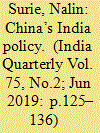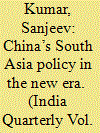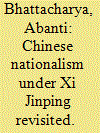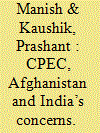|
|
|
Sort Order |
|
|
|
Items / Page
|
|
|
|
|
|
|
| Srl | Item |
| 1 |
ID:
167310


|
|
|
|
|
| Summary/Abstract |
Given the essential positive history of China’s relations with India, China’s world view and the fact of geographical contiguity, the essential approach that China follows vis-à-vis India post 1949 is based on bilateralism. The bilateral approach has defined China’s negotiations over the border as well as economic relations between the two. In the past bilateralism has allowed China to consolidate its control over Tibet and follow a mercantilist economic policy vis- a- vis India. But the change in the geopolitical status of both nations indicates that bilateral relations, after Wuhan, have been reset to represent those between two ‘major powers’ who have broader regional and global interests as well. Although bilateralism will continue to underline their policies towards each other in matters of common development, regional development or the building of a community with a shared future for humanity, China will need to redefine its approach to bilateralism by broadening and deepening it to create a truly mutual relationship.
|
|
|
|
|
|
|
|
|
|
|
|
|
|
|
|
| 2 |
ID:
167315


|
|
|
|
|
| Summary/Abstract |
Since the formation of the People’s Republic of China in 1949, Science and Technology (S&T) has been the focus area for Chinese economic development. However, little was known about China’s scientific mission, working and policies till the end of 1978. Based on the studies and the developments made, one can say that China’s S&T policy has evolved through four phases. The first phase (1949–1959) supported the development of heavy industries along the Soviet lines; the second phase (1959–1976) witnessed economic stagnation and ideological domination of technology projects; the third phase (1976–2001) focused on market-driven and product-driven research and now in her fourth phase of S&T development, since 2002, China has aimed to develop high technology industries and the nascent clean-energy or green technology with a focus on innovation.
These policy changes entirely reformed the way China’s industrial enterprises are being managed today as compared to earlier years. However, some thinkers do not consider these reforms as sweeping or successful. In order to better appreciate the implications of the S&T policy in China’s industrial transition, the article analyses the role and effects of the policy that has assisted in enhancing the country’s S&T strength and improving the competitiveness, while supporting its economic and social development.
|
|
|
|
|
|
|
|
|
|
|
|
|
|
|
|
| 3 |
ID:
167311


|
|
|
|
|
| Summary/Abstract |
In recent years, there has been a rise in China’s profile in South Asia. It is no surprise that Chinese experts have used terms, such as ‘new springtime’ in China–South Asia relations, ‘rediscovery of the strategic status of South Asia’ and ‘most relevant region with regard to the rise of China’. The objective of this article is to examine the nature and drivers of China’s South Asia policy, especially under the leadership of Xi Jinping vis-à-vis China’s policy towards the region in the past. It is not sufficient to only examine international factors or foreign and security policy in the context of the neighbouring region, such as South Asia. China’s ‘domestic periphery’ presents a significant threat to its national security. These areas are linked to neighbouring countries of South Asia and Central Asia.
The announcement by Chinese President Xi Jinping of a ‘New Era’ or ‘third era’ in the history of Communist Party of China (CPC) represents a China which is known for its dictum ‘striving for achievement’ (fenfa youwei). This is different from the second era’s policy of ‘keeping a low profile and biding the time’ proposed by Deng Xiaoping. Of course, the name of Mao Zedong is synonymous with the first era beginning from 1949.
|
|
|
|
|
|
|
|
|
|
|
|
|
|
|
|
| 4 |
ID:
167317


|
|
|
|
|
| Summary/Abstract |
In China, nationalism that took root in the era of globalization under the third-generation leadership of Jiang Zemin is principally meant to address the internal threats challenging party legitimacy and stability and not to resist the foreign enemies, as was the goal in the twentieth century. This is because internal stability is considered prerequisite to harness the potentials of globalization. Paradoxically therefore, nationalism and globalization, that are antithetical forces, go hand in hand in China. Under the current leadership, both the forces of nationalism and globalization are underscored in Xi Jinping’s dream project- the Belt and Road Initiative (BRI). Notably, the success of BRI is contingent on the persistence of globalization externally. But the rising trends of de-globalization in the West do not augur well for the BRI that has been envisaged to not only meet the demands of a slowing economy but to expand China’s global footprints, and thereby, fulfil the China Dream. Therefore, a sense of insecurity pervades Chinese nationalism. This ‘insecure’ nationalism under Xi Jinping is engendering a belligerent turn to Chinese foreign policy.
|
|
|
|
|
|
|
|
|
|
|
|
|
|
|
|
| 5 |
ID:
167318


|
|
|
|
|
| Summary/Abstract |
This paper highlights China’s views regarding CPEC and argues that stakes are very high for China in CPEC, and it is a project that must succeed if BRI is to go down in history as a success. However, CPEC’s success cannot be ensured without responding to the security challenge present in Pakistan and Afghanistan, which has the potential to jeopardise the CPEC and as a result the entire BRI. Hence, China is required to engage with both Pakistan and Afghanistan to ensure the long-term security of the CPEC. Building of CPEC and its further extension leaves India with limited options but augmenting economic, political and security concerns.
|
|
|
|
|
|
|
|
|
|
|
|
|
|
|
|
| 6 |
ID:
167313


|
|
|
|
|
| Summary/Abstract |
Noticing the gap in the existing literature, this article attempts to argue that status-seeking motives do not necessarily result in zero-sum games and hence tries to summarise conditions for status-seekers to manage conflicts and realise cooperation with one another through creative use of social mobility and creativity strategies. As a case study, this article examines the evolving relations between India and China since 2013 and demonstrates how relations between these two status-seeking states can become confrontational with conflicting status-seeking incentives. For some time, the status competition seemingly dominated their interactions, when India was not willing to accept China’s power status second only to the USA, and China reluctant to recognise India as another rising power with nuclear capabilities. After the Donglang (Doklam) standoff, both governments are finding ways to manage an indirect path for cooperation through a newly discovered multilateral framework. The elements contributing to the stability of their relations lie in their choice of international identity and political calculations in which they can engage with the other based on their shared interests in fostering solidary among developing countries.
|
|
|
|
|
|
|
|
|
|
|
|
|
|
|
|
| 7 |
ID:
167312


|
|
|
|
|
| Summary/Abstract |
The Sino-Indian border dispute has been effectively stalemated since the end of the 1962 Border War and remains a source of serious tension between the two Asian giants. Yet there were several instances throughout the 1950s and the early 1960s when the two sides could have resolved their dispute amicably. Curiously, despite several detailed historical accounts on how the Sino-Indian border dispute developed, there has been few systematic theoretical accounts exploring why this occurred. To address this gap, I utilise poliheuristic choice theory to examine the choices of the both the key decision-makers of the time, Mao Zedong and Jawaharlal Nehru. The poliheuristic choice theory illuminates why both Mao and Nehru initially chose status quo policies before embracing either compromise or escalation policies, when faced with domestic pressure at home and ideological impulses.
|
|
|
|
|
|
|
|
|
|
|
|
|
|
|
|
| 8 |
ID:
167316


|
|
|
|
|
| Summary/Abstract |
This article looks at major trends in China’s minority policy under Xi Jinping. It studies various methods implemented in order to control the unrest including the usage of technology for the purpose of monitoring people’s digital and geographic footprints. It studies development versus stability debate and takes a cursory look at how BRI intersects the identity question. It also looks at various debates underway among the Chinese intelligentsia on the proper handling of the minority issue. Trend shows that under Xi, China’s ethnicity policy has hardenened is based on ensuring that the ethnic minority groups identify themselves as Chinese first before being Uighurs or Tibetans.
|
|
|
|
|
|
|
|
|
|
|
|
|
|
|
|
| 9 |
ID:
167314


|
|
|
|
|
| Summary/Abstract |
In recent years, the Trump administration, embracing the principle of ‘America First’, adopts protectionism, doubts climate change and withdraws from many multilateral regimes in fields of trade, security, politics and global governance, while China firmly supports economic globalisation and free trade, adheres to peaceful development and advocates cooperation, openness, inclusiveness and mutual benefits. In these circumstances, there appears a heated debate on the shift of global leadership in academia and media, focusing on China. Beginning with summing up typical opinions about the issue of global leadership concerning the USA and China, the author conceptualises ‘global leadership’, analyses the nature and state of USA’s global leadership, discusses the Trump administration’s foreign policies and USA’s global leadership and comments China’s views and policies concerning global leadership. This article primarily argues that leadership, unlike hegemony, is not a zero-sum relationship, and there may be more than one country harmoniously and complementarily exerting leading roles in global affairs. Only by clearly differentiating hegemony and leadership can great powers better deal with their relations.
|
|
|
|
|
|
|
|
|
|
|
|
|
|
|
|
|
|
|
|
|